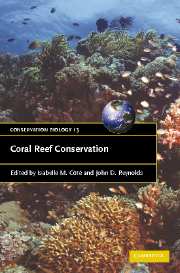Book contents
- Frontmatter
- Contents
- List of contributors
- Foreword
- Preface
- Part I Setting the stage
- Part II Uses and abuses: ecological and socio-economic issues
- Part III The way forward: tools and approache
- 9 New approaches to estimating recent ecological changes on coral reefs
- 10 Assessing the effectiveness of marine protected areas as a tool for improving coral reef management
- 11 Environmental impact assessment for coral reefs: advocating direct protective approaches
- 12 Time for a third-generation economics-based approach to coral management
- 13 Collaborative and community-based conservation of coral reefs, with reference to marine reserves in the Philippines
- 14 Education as a tool for coral reef conservation: lessons from marine protected areas
- 15 Adaptive institutions for coral reef conservation
- 16 Coral reef restoration with case studies from Florida
- 17 Redesigning coral reef conservation
- 18 Coral reef coda: what can we hope for?
- Index
- Plate section
- References
16 - Coral reef restoration with case studies from Florida
Published online by Cambridge University Press: 05 June 2012
- Frontmatter
- Contents
- List of contributors
- Foreword
- Preface
- Part I Setting the stage
- Part II Uses and abuses: ecological and socio-economic issues
- Part III The way forward: tools and approache
- 9 New approaches to estimating recent ecological changes on coral reefs
- 10 Assessing the effectiveness of marine protected areas as a tool for improving coral reef management
- 11 Environmental impact assessment for coral reefs: advocating direct protective approaches
- 12 Time for a third-generation economics-based approach to coral management
- 13 Collaborative and community-based conservation of coral reefs, with reference to marine reserves in the Philippines
- 14 Education as a tool for coral reef conservation: lessons from marine protected areas
- 15 Adaptive institutions for coral reef conservation
- 16 Coral reef restoration with case studies from Florida
- 17 Redesigning coral reef conservation
- 18 Coral reef coda: what can we hope for?
- Index
- Plate section
- References
Summary
INTRODUCTION
While a coral reef may appear to be a formidable mass, its structure is easily damaged by disturbances. This is because reefs are layer cakes of coral skeletons, remains of other calcifying organisms, and sediment infill (in some cases even sedimentary strata). Typically 30–40% of the reef mass is void space which may be either filled with loose sediments or remain open. Fungi, algae, sponges, snails and fish work like miners to rasp, dissolve or bore through the coral skeletons, creating a labyrinth of tunnels and spaces.
The structural fragility of coral reefs leads to susceptibility to a number of disturbances. Natural events that have immediate impacts on their structure include meteorological phenomena (hurricanes, typhoons, frontal events, severe doldrums), earthquakes and tsunamis, and lava flows. A class-five hurricane may totally destroy a high-profile coral reef, as occurred with Hurricane Hattie in Belize and Hurricane Allen in Jamaica (Stoddart, 1962; Woodley et al., 1981). On the other hand, smaller storms and fast-moving large storms are less destructive. Hurricanes Donna and Betsy (1960 and 1964) and Andrew (1992) damaged coral reefs off the Florida Keys, but reefs appeared to recover within ten years after Donna (Springer and McErlean, 1962; Shinn, 1976). Some of these natural stress agents have a spatial context of entire ocean basins, e.g. the 1998–99 mass bleaching event (Goldberg and Wilkinson, 2004). Others are more moderate in space and time such as a hurricane that influences hundreds of hectares of reef.
- Type
- Chapter
- Information
- Coral Reef Conservation , pp. 478 - 514Publisher: Cambridge University PressPrint publication year: 2006
References
- 5
- Cited by



